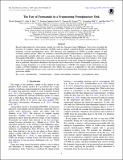Files in this item
The fate of formamide in a fragmenting protoplanetary disk
Item metadata
| dc.contributor.author | Quénard, David | |
| dc.contributor.author | Ilee, John D. | |
| dc.contributor.author | Jiménez-Serra, Izaskun | |
| dc.contributor.author | Forgan, Duncan H. | |
| dc.contributor.author | Hall, Cassandra | |
| dc.contributor.author | Rice, Ken | |
| dc.date.accessioned | 2018-12-07T11:30:06Z | |
| dc.date.available | 2018-12-07T11:30:06Z | |
| dc.date.issued | 2018-11-13 | |
| dc.identifier | 256866577 | |
| dc.identifier | 1a3a3e2c-57ec-4e18-af9f-4e8f64fd9daa | |
| dc.identifier | 85057175368 | |
| dc.identifier | 000450221800009 | |
| dc.identifier.citation | Quénard , D , Ilee , J D , Jiménez-Serra , I , Forgan , D H , Hall , C & Rice , K 2018 , ' The fate of formamide in a fragmenting protoplanetary disk ' , Astrophysical Journal , vol. 868 , no. 1 , 9 . https://doi.org/10.3847/1538-4357/aae4dd | en |
| dc.identifier.issn | 0004-637X | |
| dc.identifier.uri | https://hdl.handle.net/10023/16644 | |
| dc.description | D.Q. acknowledges the support received from the STFC through an Ernest Rutherford Grant (grant No. ST/M004139). J.D.I. acknowledges support from the DISCSIM project, grant agreement 341137 under ERC-2013-ADG, and support from the STFC (grant No. ST/R000549/1). I.J.-S. acknowledges partial support by the MINECO and FEDER funding under grants ESP2015-65597-C4-1 and ESP2017-86582-C4-1-R. D.H.F. acknowledges support from the ECOGAL project, grant agreement 291227, under ERC-2011-ADG. C.H. acknowledges that this project has received funding from the European Research Council (ERC) under the European Union's Horizon 2020 research and innovation program (grant agreement No 681601). C.H. is a Winton Fellow and this research has been supported by Winton Philanthropies. | en |
| dc.description.abstract | Recent high-sensitivity observations carried out with the Atacama Large Millimeter Array have revealed the presence of complex organic molecules (COMs) such as methyl cyanide (CH3CN) and methanol (CH3OH) in relatively evolved protoplanetary discs. The behavior and abundance of COMs in earlier phases of disk evolution remain unclear. Here, we combine a smoothed particle hydrodynamics simulation of a fragmenting, gravitationally unstable disk with a gas-grain chemical code. We use this to investigate the evolution of formamide (NH2CHO), a prebiotic species, in both the disk and in the fragments that form within it. Our results show that formamide remains frozen onto grains in the majority of the disks where the temperatures are <100 K, with a predicted solid-phase abundance that matches those observed in comets. Formamide is present in the gas phase in three fragments as a result of the high temperatures (≥200 K), but remains in the solid phase in one colder (≤150 K) fragment. The timescale over which this occurs is comparable to the dust sedimentation timescales, suggesting that any rocky core that is formed would inherit their formamide content directly from the protosolar nebula. | |
| dc.format.extent | 7 | |
| dc.format.extent | 1114158 | |
| dc.language.iso | eng | |
| dc.relation.ispartof | Astrophysical Journal | en |
| dc.subject | Astrochemistry | en |
| dc.subject | Hydrodynamics | en |
| dc.subject | Planets and satellites: formation | en |
| dc.subject | Protoplanetary disks | en |
| dc.subject | QB Astronomy | en |
| dc.subject | QD Chemistry | en |
| dc.subject | Astronomy and Astrophysics | en |
| dc.subject | Space and Planetary Science | en |
| dc.subject | NDAS | en |
| dc.subject.lcc | QB | en |
| dc.subject.lcc | QD | en |
| dc.title | The fate of formamide in a fragmenting protoplanetary disk | en |
| dc.type | Journal article | en |
| dc.contributor.sponsor | European Research Council | en |
| dc.contributor.institution | University of St Andrews. St Andrews Centre for Exoplanet Science | en |
| dc.contributor.institution | University of St Andrews. School of Physics and Astronomy | en |
| dc.identifier.doi | 10.3847/1538-4357/aae4dd | |
| dc.description.status | Peer reviewed | en |
| dc.identifier.grantnumber | en |
This item appears in the following Collection(s)
Items in the St Andrews Research Repository are protected by copyright, with all rights reserved, unless otherwise indicated.

